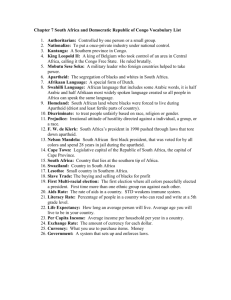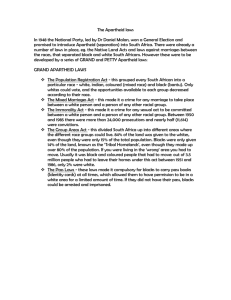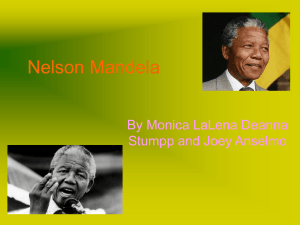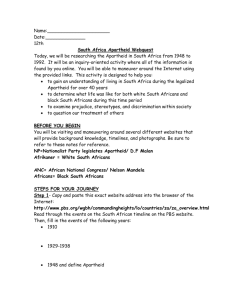Apartheid in South Africa
advertisement
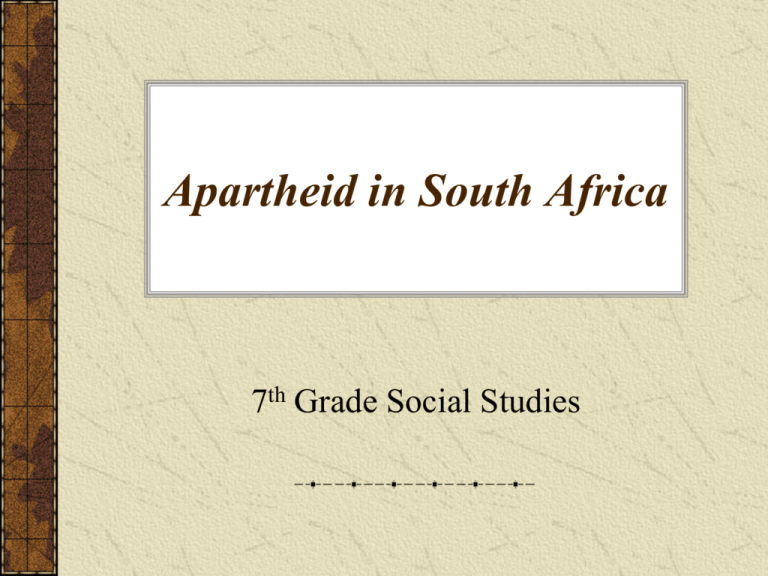
Apartheid in South Africa 7th Grade Social Studies What is Apartheid? The term apartheid (from the Afrikaans word for "apartness") was coined in the 1930s and used as a political slogan of the National Party in the early 1940s, but the policy itself extends back to the beginning of white settlers (the Dutch) in South Africa in 1652. After the primarily Afrikaner Nationalists came to power in 1948, apartheid was implemented under law. How did the new government enforce this new policy? The implementation of the policy, later referred to as "separate development," was made possible by the Population Registration Act of 1950, which put all South Africans into three racial categories: Bantu (black African), White, or Colored (of mixed race). A fourth category, Asian (Indians and Pakistanis), was added later. Afrikaner Nationalists’ policies The system of apartheid was enforced by a series of laws passed in the 1950s: the Group Areas Act of 1950 assigned races to different residential and business sections in urban areas The Land Acts of 1954 and 1955 restricted nonwhite residence to specific areas. These laws further restricted the already limited right of black Africans to own land, entrenching the white minority's control of over 80 percent of South African land. Other laws prohibited most social interaction between the races; enforced the segregation of public facilities, including educational; created race-specific jobs; limited the powers of nonwhite unions; and minimized nonwhite participation in government. More Restrictions!!! The Bantu Authorities Act of 1951 and the Promotion of Bantu Self-Government Act of 1959 furthered these divisions between the races by creating ten African "homelands“ to be selfgoverned by the various “tribes.” The Bantu Homelands Citizenship Act of 1970 made every black South African a citizen of one of the homelands which eliminated black Africans from South African politics. A Black South African shows his passbook issued by the Government. Blacks were required to carry passes that determined where they could live and work. A girl looking through a window of her shack in Cross Roads, 1978. Segregated public facilities in Johannesburg, 1985. Young, black South Africans looking in on a game of soccer at an all-white school in Johannesburg. Government spending, about 10 times more for white children than for black, clearly showed the inequality designed to give whites more economic and political power. Poorly trained teachers, overcrowded classrooms, and inadequate recreational facilities were normal for black children, if in fact they had any schooling available at all. More signs of Apartheid Young coal miners in South Africa in 1988. People Respond A number of black political groups, often supported by sympathetic whites, opposed apartheid using a variety of tactics, including violence, strikes, demonstrations, and sabotage - strategies that often met with severe consequences from the government. Key word is “selective” Apartheid was also denounced by the international community: in 1961 South Africa was forced to withdraw from the British Commonwealth by member countries who were critical of the apartheid system, and in 1985 the governments of the United States and Great Britain imposed selective economic sanctions on South Africa in protest of its racial policy. Reform!!! As antiapartheid pressure mounted within and outside of South Africa, the South African government, led by President F. W. de Klerk, began to dismantle the apartheid system in the early 1990s. The year 1990 brought a National Party government dedicated to reform and also saw the legalization of formerly banned black congresses (including the ANC— African National Congress) and the release of imprisoned black leaders. In 1994 the country's constitution was rewritten and free general elections were held for the first time in its history, and with Nelson Mandela's election as South Africa's first black president, the last remnants of the apartheid system were finally outlawed. What role did these men play in ending apartheid in South Africa? NELSON MANDELA F.W. de KLERK Nelson Mandela & F. W. de Klerk Throughout the years of Apartheid, two groups were working to end this South African regime – the African National Congress led by Nelson Mandela, and the Pan African Congress. Riots and fighting took place constantly, and Nelson Mandela was sentenced to life in prison for his work against the regime. Eventually, the South African government had to admit that their policy of apartheid had no place in the modern world. In 1990, South African President F.W. de Klerk agreed to allow the ANC to operate as a legal party and he released Nelson Mandela from prison after he had served 27 years in prison. de Klerk also began to repeal the apartheid laws. The numbers don’t lie . . . Blacks Population 19 million Whites 4.5 million Land allocation 13% 87% Share of national income <20% 75% Minimum taxable income 360 rands 750 rands Doctors/population 1/44,000 1/400 Infant mortality rate 20%-40% 2.7% Annual expenditure on education per student $45 $696 1/60 1/22 Teacher/student ratio


